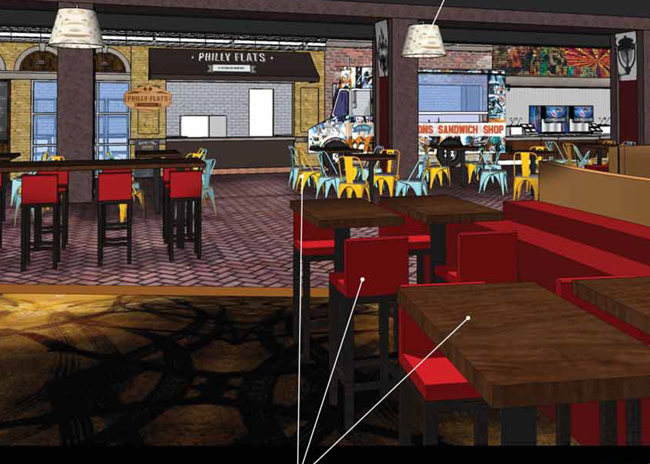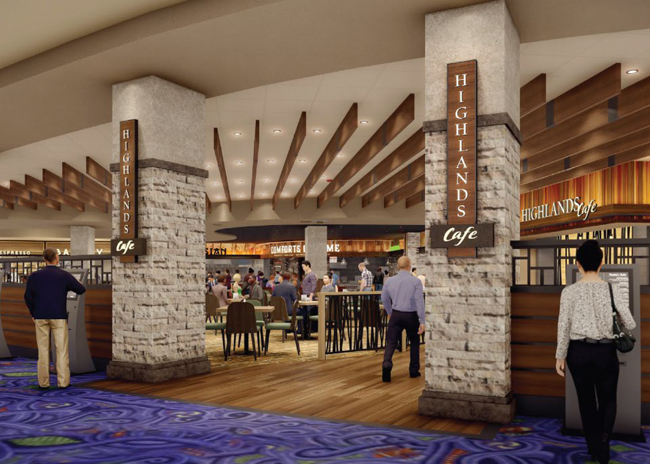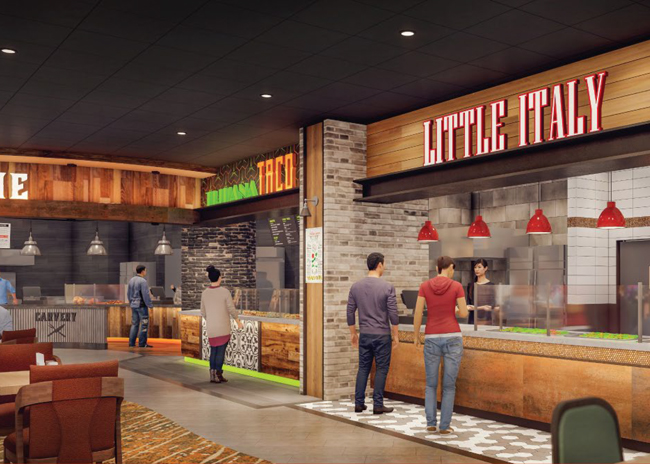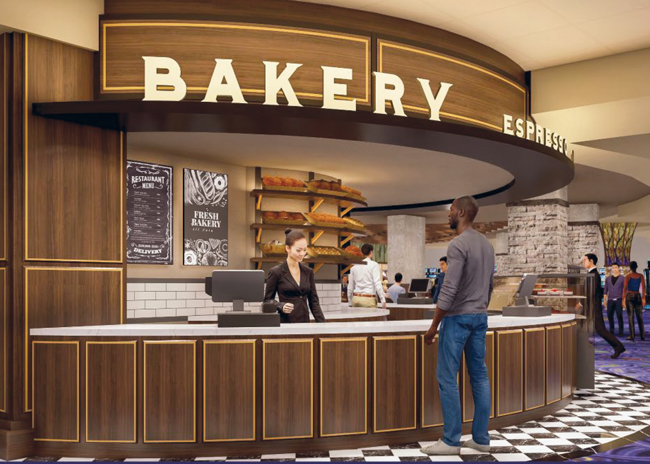Foodservice in the gaming sector continues to evolve, pandemic or not.
Even before COVID-19 emerged last spring, casino restaurants had gone through a number of ideations necessary to adapt to the ever-changing gaming industry. From their start as lavish buffet concepts geared toward satiating gamblers, then moving toward more upscale fine-dining concepts meant to attract those looking for a night out of both eating and testing their luck, restaurants became more of an attraction and incentive than a value-add at casinos.
When the economy was booming, the gaming industry was hot, according to Los Angeles-based IBISWorld in an August 2020 report. Yet, the gaming sector has faced struggles throughout the U.S. over the last five years, attributed to new casino hotels and additional states legalizing gambling, which increased competition. This led to annual industry revenue declining between 2015 and by a forecasted 6.3% for 2020 —$14.5 billion — at non-hotel casinos. Despite the decrease, revenue from food and beverage sales at non-hotel casinos was anticipated to reach 7.9% of industry revenue in 2020, an increase of $4 billion for food and $1.9 billion for beverages over the last five years.
Changing Formats
 These renderings of a casino food hall demonstrate how a space that formerly housed a self-serve buffet concept has been transformed and updated to be a more efficient profit center.Foodservice formats largely depend on whether the casino functions as a gaming-only property, provides lodging or serves as a full-scale resort. “Once a visit becomes an overnight experience, the demand for more food and beverage options becomes important,” says Craig Pendleton, president of National Foodservice Consulting Inc., located in Surprise, Ariz. Yet, the pandemic-influenced debate continues over whether to open or reopen dining facilities, he adds.
These renderings of a casino food hall demonstrate how a space that formerly housed a self-serve buffet concept has been transformed and updated to be a more efficient profit center.Foodservice formats largely depend on whether the casino functions as a gaming-only property, provides lodging or serves as a full-scale resort. “Once a visit becomes an overnight experience, the demand for more food and beverage options becomes important,” says Craig Pendleton, president of National Foodservice Consulting Inc., located in Surprise, Ariz. Yet, the pandemic-influenced debate continues over whether to open or reopen dining facilities, he adds.
As they contemplate their options, those running the gaming facilities must decide what type of operation will be the most profitable. “Some leaders of major casinos have stated that as they open or reopen their amenities, only breakeven or profitable outlets will be considered at this time. Food and beverage outlets already operate on slim margins. With the additional PPE requirements, profit is doubtful for many of these restaurants,” Pendleton explains.
Even after operators determine which formats to reopen, they must contend with state and local restrictions implemented with the hopes of slowing the spread of COVID-19. Many Las Vegas casinos opted to close their buffet operations. “Many casinos are deciding if in the future they will opt for a full-service buffet — a very costly route — or eliminate the buffet and repurpose the space into a food hall/food court or non-food and beverage space,” Pendleton says.
Cherokee National Enterprises’ Cherokee Entertainment casino, which has 10 locations in Oklahoma, began changing its River Cane restaurants in West Siloam Springs, Tulsa and Roland from buffets to food halls in 2020. “With COVID-19, they shut down buffets, and the challenge will be getting people to come back in,” says Arlene Spiegel, president of Arlene Spiegel & Associates, New York City, who is working on the Cherokee Entertainment projects. “The casinos also are connected to hotels and have visitors and tourists coming in. A big part of the marketing, incentives and accommodations was the buffet, which took up 25,000 to 30,000 square feet of the property. They needed to decide what to do with that space.”
 A glimpse into Cherokee Nation’s River Cane Food Hall, including the ordering kiosks and separate full-service cafe.Although some casino foodservice operators, like Cherokee Entertainment, are reinventing the front of the house and converting out of the buffet format, kitchens largely remain unchanged. “Casinos receive bulk prep and cook in their commissaries or kitchens,” Spiegel says. “However, we formerly had open stations scattered all over for self-service — some with staff support for carveries or restocking — but by and large, people using tongs, ladles, fingers and self-serve beverage stations.” That kind of self-serve approach is no longer happening for the most part.
A glimpse into Cherokee Nation’s River Cane Food Hall, including the ordering kiosks and separate full-service cafe.Although some casino foodservice operators, like Cherokee Entertainment, are reinventing the front of the house and converting out of the buffet format, kitchens largely remain unchanged. “Casinos receive bulk prep and cook in their commissaries or kitchens,” Spiegel says. “However, we formerly had open stations scattered all over for self-service — some with staff support for carveries or restocking — but by and large, people using tongs, ladles, fingers and self-serve beverage stations.” That kind of self-serve approach is no longer happening for the most part.
Though some gaming companies have decided to keep buffet concepts, many continue to reimagine their interpretations of this long-time casino staple. “These casino restaurants are still offering an array of foods but only provide table service with QR code ordering, so it’s not the same experience [as a traditional buffet],” Spiegel explains. “And the back of house still requires staff for prepping and cooking meals.”
Transitioning away from buffets represents a trend among many of Spiegel’s gaming clients that precedes the pandemic. “I converted one five years ago for Harrah’s in Pennsylvania,” she says. “The 30,000-square-foot buffet was a battle-ax — not attractive and created lots of waste.”
Harrah’s was seeking to rebrand the menu to expand its demographic of seniors to include those in their 50s and 60s looking for a higher-level experience. “We converted Harrah’s restaurant into a streetscape food hall model called The Block, and it was very successful,” Spiegel says.
Cherokee Entertainment’s River Cane Food Hall design took a similar approach. Updates include a new facade and diverse offerings, which feature comfort food, barbecue and Mexican fare. “It encompasses an around-the-world section with global foods, a bakery cafe and a full-service sit-down restaurant,” Spiegel says. “The awesome part with this project is we’re not touching the back of house, just the front, and that will appear as individual restaurants with kiosks for ordering.” River Cane also will provide options for carryout, off-premises delivery and delivery to the gaming floor.
The ordering process starts at kiosk-style counters with limited menu offerings. For the casino, this results in less labor due to enhanced back-of-the-house efficiencies and more streamlined menus. “For example, the Mexican menu would have eight items, along with signature beverages like frozen margaritas rather than cheaper self-serve beverages,” Spiegel says. “Instead of a one-price, all-you-can-eat buffet, the food hall is priced like a traditional restaurant, with meals and beverages costing more but the quality being elevated. We’re also eliminating the waste and labor of a buffet.”
Repurposing, as well as developing new casino restaurants, comes with a new set of ground rules for Gary Jacobs, principal at New York-based Jacobs Doland Beer. The requests from clients are to be conservative in ways he hasn’t had to in the past. “We’re seeing a move toward value and being asked about depth of reuse more than we have historically. The food hall model is one option,” he says. “We’re currently converting a restaurant in Mohegan Sun in Las Vegas [from buffet service to full-service].”
Adaptive reuse of existing equipment and infrastructure lead the charge today, replacing the more substantial budgets from the days of yore. “For example,” Jacobs says, “we’ll do things like repurpose exhaust systems and refrigeration and have clients ask about utilizing existing equipment to minimize upfront costs. We used to get drawings with walls and understand where the current exhaust was, with the major investments being black iron and scrubbers. Now, the scope of things that are staying has been extended. We are more likely to keep hoods where they are and calculate the equipment’s useful life, rather than starting fresh.”
Although he does not see downsizing among gaming-related foodservice spaces, looking ahead, Jacobs says it will be interesting to see how many venues will be reactivated. “If a casino doesn’t have a big guest density, can you support three snack options for $15-$20 each off of the casino floor, or do you have to bring it down to two snack options?” he asks.
Jacobs notes another consideration: Increasing competition traditionally drives casinos to constantly innovate and change to remain the newest and most interesting option on the market. “We will see very creative ways in freshening things up in terms of existing venues rather than complete replacements,” he predicts. “It’s more about menu updates, guest experience and interior updates than completely gutting a space.”
Increased casino operating costs, specifically labor, were never a factor in designs in the past for Jacobs Doland Beer, Jacobs says, but have become something the foodservice design firm has had to be more mindful of in recent years. “My curiosity going forward will be the scaling,” Jacobs says. “I don’t think we’ll flip a post-COVID-19 switch and be at full capacity, so it will be interesting to see how casino restaurants are scaled.”
Extreme Business Model Shifts
 Marketing for and positioning of casino restaurants will most likely change, depending on the operation and its offerings. “In a nutshell, COVID has provided a beta test of casino food and beverage operations that would never have been possible without a pandemic, closures and the opportunity for casino operators to clearly calculate the benefits and ROI of these operations as they relate to gaming and total EBITA,” says Pendleton.
Marketing for and positioning of casino restaurants will most likely change, depending on the operation and its offerings. “In a nutshell, COVID has provided a beta test of casino food and beverage operations that would never have been possible without a pandemic, closures and the opportunity for casino operators to clearly calculate the benefits and ROI of these operations as they relate to gaming and total EBITA,” says Pendleton.
“In the past, the casino industry had typically provided a large amount of diverse food and beverage offerings, which were largely based upon positioning themselves ahead of the competition,” Pendleton says. “Many of these foodservice outlets did not break even and typically lost money.”
For most casino operators, in terms of value and profit, it is not the food and beverages that bring in pure gaming customers. “This is not a deciding factor of whether gamblers visit,” Pendleton says. “Operators now can clearly see that much of the additional customer traffic attracted by the food and beverage outlets and other non-gaming amenities tends to be visitors who provide a lower level of gaming and profit to the casino.”
Still, as a form of reward for gamblers, food and beverage consistently ranks in second place after free-play/bonus-play, Pendleton says. This can be an additional factor in the decision to reopen a favorite outlet moving forward.
“Some properties are considering offering food and beverage rewards for redemption of gaming points in the form of carryout meals at the end of a casino visit for those players who are still not comfortable sitting in a restaurant dining room for an entire meal,” Pendleton says.
Accessibility represents another factor as the pandemic limits indoor dining capacities. “In the past, providing casino restaurants for dining-only customers was acceptable for many properties,” Pendleton says. “With restricted capacities and additional sanitation resources required, many of these operators are debating whether dining-only guests who compete for casino resources, such as occupancy and parking, should fit the business model moving forward.”
Operators have other options from which to choose. With the food hall concept, for example, casinos have the option of shutting down half the kiosks to cut down on labor and other expenses during less busy periods. “Foodservice never has to close, but all venues don’t need to always be open,” Spiegel explains. “This way, casinos will always be able to serve guests in a profitable, pragmatic way.”
In positioning these venues, many variables need consideration, including tabletop items, glassware, recipes, training, uniforms and technical training. “It’s about not only optimizing the economies of the back of house but also creating a facade and programming where guests can have a visual, authentic, multiconcept experience or can sit down in full-service restaurants,” Spiegel says. “It’s like having a buffet experience without actual self-serve areas.”
 Logistics and technology will also play a role in the future of foodservice at gaming facilities. “Employing an internal logistics person helps in getting food to different parts of the property and even offering new types of food due to the pandemic,” Spiegel says. “There’s opportunity to [expand service and] offer take-home meals and become a restaurant outlet for local businesspeople and shoppers. As long as you have a kitchen, food, a chef and communicate how it’s available, the logistics and technology will add to the success of these programs.”
Logistics and technology will also play a role in the future of foodservice at gaming facilities. “Employing an internal logistics person helps in getting food to different parts of the property and even offering new types of food due to the pandemic,” Spiegel says. “There’s opportunity to [expand service and] offer take-home meals and become a restaurant outlet for local businesspeople and shoppers. As long as you have a kitchen, food, a chef and communicate how it’s available, the logistics and technology will add to the success of these programs.”
Casinos with a commitment to foodservice will make it work, Spiegel says, while others will simply walk away. “There’s something to be said for having flexibility and hybridization: where kitchens are set up, where you’re located, training of staff, menu engineering,” she says. “We’re in the midst of it with casinos right now.”
Jacobs says moving forward, consider two pieces to the puzzle: one, casinos that have fewer guests won’t need as many venues, and two, the necessary support for foodservice operations is crucial. “It’s a balance,” he says. “How far do you want people to go from that gaming table to get something to eat? And if they do walk away for food, what is the cost benefit of that to the casino?
“We’re somewhat limited with these projects since budgets are lower,” Jacobs continues. “People have always looked for a high level of indulgence and moderate price in the casino buffet experience, and we have to convey this. I’m not sure how much we will be adapting our projects with an eye toward the post-COVID-19 world, but we will see a move toward attended service. The challenge is to provide people with a sense of value, and I don’t know where that will go.”



